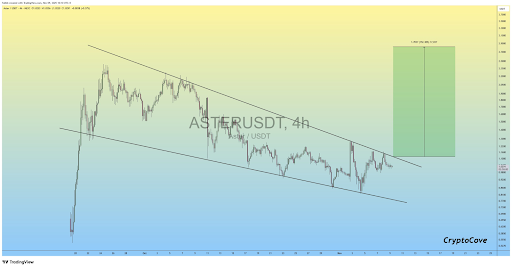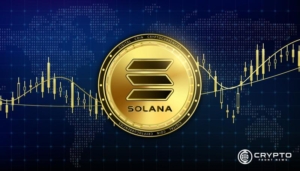- ASTER is showing decreasing bearish momentum and suggesting a potential breakout toward $1.70 in the near term.
- Active buybacks are reducing the circulating supply, creating a deliberate accumulation and institutional interest that supports price growth potential.
- Price consolidation and sharp upward moves indicate growing trader confidence and reinforced support for bullish trends.
ASTER technical patterns are suggesting potential upward movement. High transaction activity and buyback strategies indicate focused market positioning as analysts closely monitor for any signs of a breakout.
Falling Wedge Pattern Signals Breakout Potential
A falling wedge pattern is often associated with bullish reversals, and ASTERs is marked by two converging downward trendlines, showing decreasing bearish momentum over time. Prices have been making lower highs and lows while approaching the wedge’s apex.
Analysts note that price compression near the wedge apex suggests a potential breakout. The green projection box in the charts indicates a target around $1.70, a massive 152% increase from the current level. Strong breakout confirmation would likely require increased trading volume and momentum.

The pattern is reinforced by repeated retests of the upper trendline and clear support at the lower boundary. Such price behavior reflects weakening selling pressure and growing market stability. Traders are advised to consider risk management strategies due to volatility near breakout points.
Active Buybacks and Accumulation Patterns
The Astar team has increased the buyback rate to $7,500 per minute, totaling $10.8 million daily if maintained. Half of these buybacks are burned, removing $5.4 million of ASTER from circulation each day. This mechanism reduces supply and may support upward price movement.
Recent transactions show consistent buy orders around $7,500, equivalent to approximately 7,200 ASTER per trade. Trades occur in tight price ranges, suggesting deliberate accumulation rather than casual retail activity.
The repetitive and uniform nature of these transactions indicates possible institutional or whale participation. This accumulation aligns with the earlier falling wedge structure and may support a future breakout. Traders observing these patterns see growing confidence in short-term bullish prospects.
Price Movement and Market Activity
ASTER’s price has stayed between $1.01 and $1.04 over the past 24 hours; small drops were quickly followed by buying, keeping the price stable. Earlier, ASTER rose sharply from $1.03 to nearly $1.09, gaining about 6% in a few hours.
Trading volume also increased during the surge, showing that more buyers entered the market and supported the price rise.
Higher highs around $1.05 support and a strong upward trend suggest that buyers are confident as they approach resistance around $1.10–$1.12. Watching these levels helps track short-term price movements.





